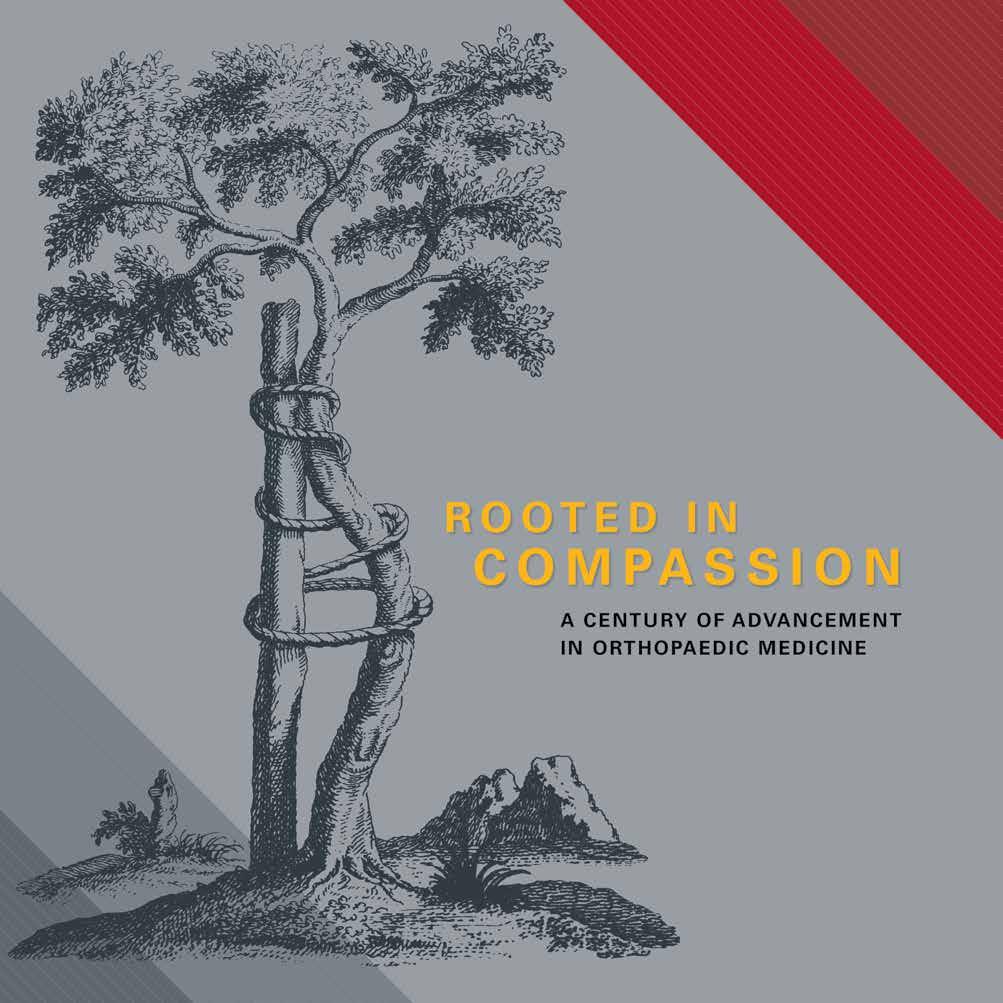
University of Nebraska Medical Center Department of Orthopaedic Surgery and Rehabilitation
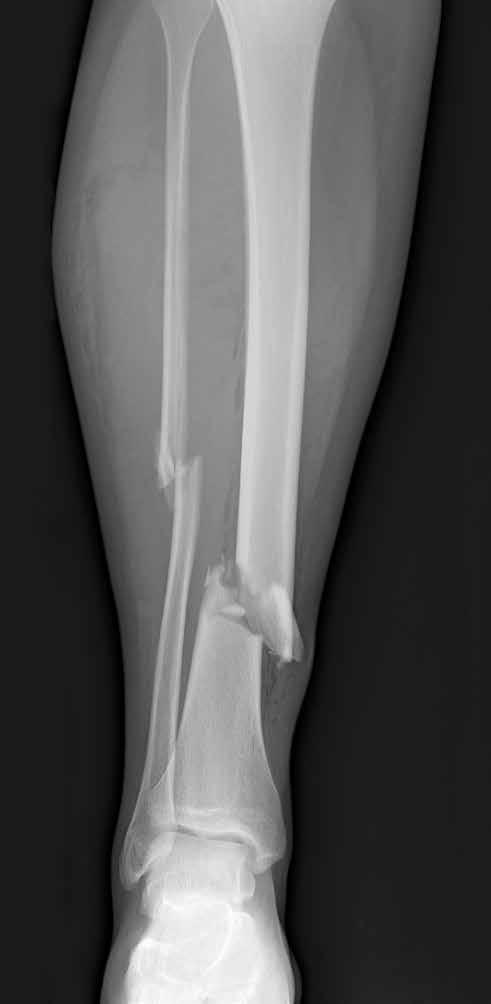
Mission Statement
Patient Care
Our surgeons are a team of dedicated, caring health professionals who specialize in the prevention, diagnosis, and treatment of musculoskeletal disorders in children, adolescents and adults. We provide quality, cost-effective care in all nine orthopaedic subspecialties, to more than 50,000 patients each year from Nebraska, the Midwest, and around the world.
Research
In our laboratories, cutting-edge research is being performed to define tomorrow’s treatment methods. We are doing innovative research focused on the areas of musculoskeletal diseases, molecular biology and genetics, the development of less-invasive surgical techniques, knee implant simulation, and computer-aided and robotic surgery.
Education
Through the orthopaedic residency program at UNMC, we are not only creating the orthopaedic surgeons of tomorrow, we are investing in Nebraska by cultivating promising educators who will teach the orthopaedic surgeons of generations to come. In addition, doctors throughout the region regard our program as a source of continuing education on the latest techniques for the treatment and prevention of bone and joint conditions.
The University of Nebraska Medical Center was No. 1 in U.S. News & World Report’s 2021-22 rankings for Best Hospitals in Nebraska. In addition, Orthopaedics was among five UNMC specialties rated as high performing on the prestigious list. UNMC’s pediatric clinical partner, Children’s Hospital & Medical Center, was most recently recognized as a Best Children’s Hospital in orthopaedics in 2019-20.
A Legacy of Innovation
A CENTURY OF ONGOING ADVANCEMENT in orthopaedic medicine, surgery and care in our community comes to life in this ambitious book by Dr. Kevin L. Garvin and the Department of Orthopaedic Surgery and Rehabilitation at the University of Nebraska Medical Center.
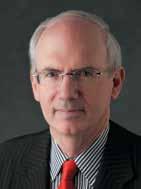
“Rooted in Compassion” takes a fascinating – and comprehensive – look at 100 years of pioneering programs, treatments, research, innovation and philanthropy that have resulted in a truly world-class approach to improving the lives of those with musculoskeletal disorders. The historic images, clinical experiences and personal accounts chronicle the legacy of a modern, forward-facing Department of Orthopaedics.
We see, too, the department’s commitment to educating and training future generations of experts who have and continue to give back to the communities they serve locally, across the nation, and around the world. Many have been noted for their academic excellence in the areas of research and education and training, others in clinical care, but all for a blend of compassion and caring, as they apply their knowledge and skill.
This manuscript also gives testament to the ongoing quest to learn more about causes of a wide spectrum of afflictions and ways to prevent them, as well as develop state-of-theart treatments that have become so critical for mobility-related maladies. Research on bone metabolism and healing, development of clinically applicable prosthesis, stereoscopic robotic surgery, and so many more areas, have been core to the mission of our faculty, staff, and learners going back to the very beginnings of this department.
The ability to better understand these diseases and to find ways to restore function, to ease pain and suffering, have underscored the true roots in compassion and have distinguished the UNMC Department of Orthopaedic Surgery for generations and generations. In addition, access to truly world-class and innovative clinical care has been the hallmark, blended with the educational and research discovery environment.
The opportunity to provide truly compassionate healing for a wide spectrum of those afflicted across all ages, races, genders and economic spectrums, has underpinned the approach to care and has formed the basis of the caring for patients with orthopaedic maladies. The opportunity to learn from our patients and their families and, at the same time, to help provide a normal quality and quantity of life has been the goal consistent with the mission and values of our organization.
“Rooted in Compassion” nicely depicts the legacy of those who have had the privilege to lead this department, those who are pioneers undaunted by clinical and scientific challenges and willing to push the frontiers of Orthopaedics forward.
4 INTRODUCTION
Jeffrey P. Gold, M.D.
Early on, Dr. J.P. Lord broke through many important barriers. Most recently, under the leadership of Dr. Garvin, the department has continued to thrive across the entirety of its educational, research and clinical missions. Fueled by the energy of a world-class academic medical center and generously supported by the private philanthropic community, Orthopaedic Medicine is an exemplar for all UNMC departments, institutes, centers of excellence, and colleges as a wonderful blend across each of the pedestals of the academic mission.
As we like to say, “serious medicine, extraordinary care” always rooted in compassion, always dedicated to a brighter future, always building on the shoulders of giants in their field but having a clear vision of a better tomorrow. Congratulations to all honored in this manuscript. Without any question, the best is yet to come.
Jeffrey P. Gold, M.D. Chancellor, University of Nebraska Medical Center

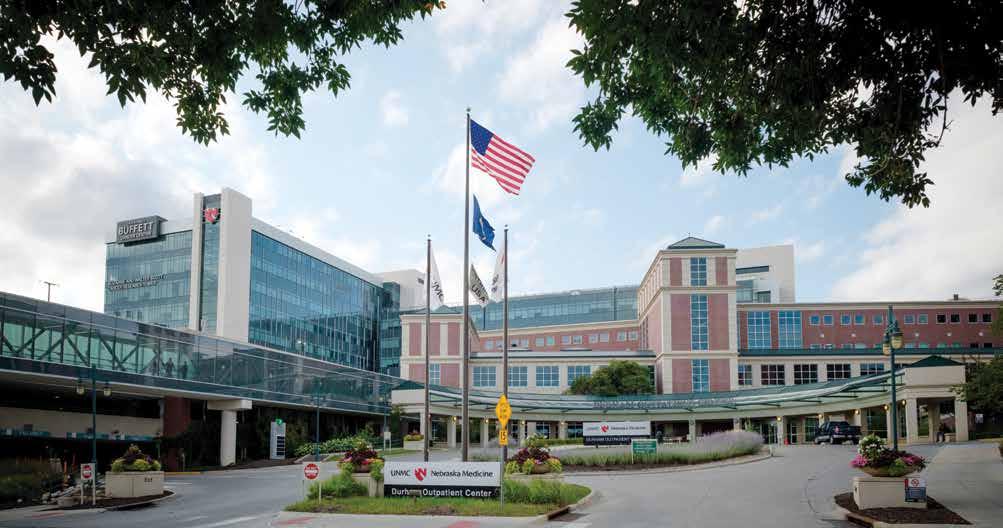
INTRODUCTION 5
Durham Outpatient Center, UNMC.
PART I
1919-1969
Early History of Orthopaedics in Nebraska & The Department’s First 50 Years
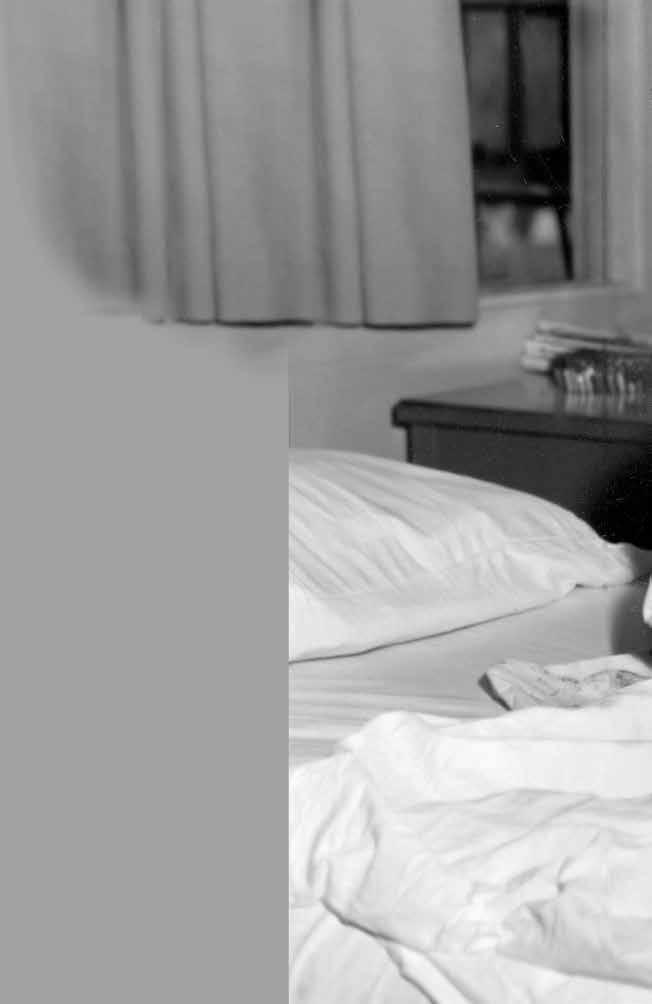
6
 The 1950s: A boy with his leg in traction after a football injury.
The 1950s: A boy with his leg in traction after a football injury.
Ancient Tradition, Modern Specialization
Orthopaedic surgery and rehabilitation is a relatively recent specialization in the history of Western medicine. The root of orthopaedics, however, dates to the dawn of human civilization. Anthropologist Margaret Mead cites this evidence: a 15,000-year-old human femur that showed signs of healing from a fracture. Such an achievement of musculoskeletal recovery could have only occurred with extended assistance from fellow hunter-gatherers. Preserved in the thighbone specimen, Mead argued that this evidence of ancient compassion marked the earliest proof of human civilization.
Later, New Stone Age archaeological sites from around the world reveal prehistoric limb amputations, non-operative bone unions and rehabilitation efforts with splints made of clay or fresh rawhide soaked in water. Carvings on ancient temple walls showing mummies entombed with elaborate splints and crutches suggest the presence of protoorthopaedics in ancient Egypt, several millennia before the term “orthopaedics” appeared in the historical record.
Personalities of ancient medical lore — from Hippocrates in Greece, who wrote that “there is no better training ground for the surgeon than war,” to the Roman gladiatorial physician Galen, considered the “father of sports medicine,” referred extensively to techniques and procedures that provided a foundation for continued orthopaedic advancements into the Renaissance. But the word “orthopaedics” didn’t exist yet.
The structured field of specialization now known as orthopaedics gradually coalesced with advancements in general surgery, prosthetic innovations and diverse medical improvements relating to the complex system of bones, joints, ligaments, tendons, muscles and nerves that allow the human body to move. The singular word now used to encompass that expansive field was first used in the mid-18th century.
The scamnum, invented by Hippocrates and illustrated in 1544 by Guido Guidi, used tension to aid in setting bones.

8 EARLY HISTORY
French physician and professor Nicolas Andry de Bois-Regard coined the term “orthopaedics” in his 1741 text, “L’Orthopedie ou l’art d’Homme,” a book exploring the treatment of childhood musculoskeletal disorders and diseases. The word orthopaedic comes from Greek: orthos, meaning “straight, correct” and paideia, meaning “rearing of children.” Many subsequent early orthopaedists focused their careers on the correction of musculoskeletal deformity in children including polio, clubfoot and scoliosis.

By the early 20th century, the historically child-centric root of modern orthopaedics had emerged in Nebraska. Dr. John Prentiss Lord (1860-1940), an Omaha orthopaedic surgeon, became a guiding force for the Nebraska Society for Crippled Children when it chartered in 1919. His advocacy on behalf of the new charity was the start of a lifelong passion that would long associate the Lord name with service to Omaha youth with disabilities. Lord was also the first chairman of the Department of Orthopaedics at the University of Nebraska College of Medicine from 1919 through 1931, making him a forefather to the contemporary University of Nebraska Medical Center Department of Orthopaedic Surgery and Rehabilitation. Andry’s seminal book, “Orthopédie,” included an illustration of a crooked tree anchored to a straight stake; the image became a universal symbol for orthopaedics and has remained important for UNMC’s orthopaedic department. Past department annual reports have featured the image, and it is preserved in the official logo of the national American Board of Orthopaedic Surgery.

“L’Orthopedie ou l’art d’Homme,” published in 1741, included an illustration of a crooked tree anchored to a straight stake. The image, a universal symbol for orthopaedics, has remained important to UNMC’s Orthopaedic Department.
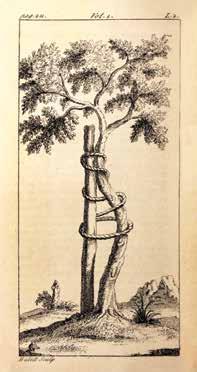
EARLY HISTORY 9
PART II
1969-2019
The Beginning of an Academic Orthopaedic Surgery Department
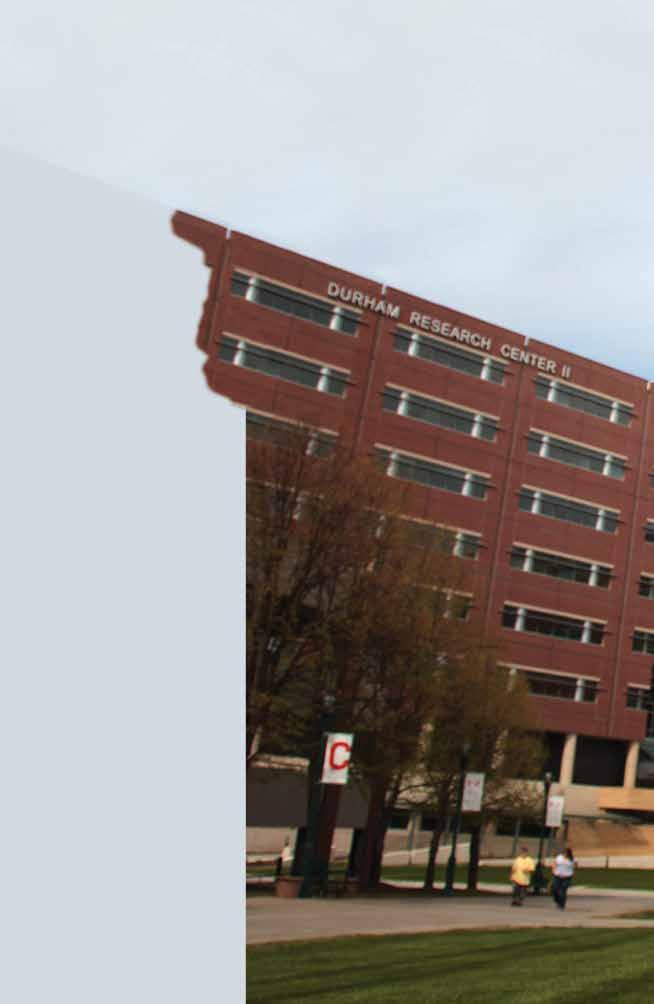
56
2011: A year after arm surgery by Dr. Sean McGarry, a boy is able to play catch with his father.

Kevin L. Garvin, M.D. Professor and Chair, Department of Orthopaedic Surgery and Rehabilitation, 2000-present
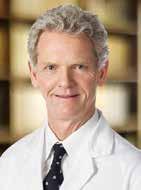
The Garvin Era: 2000-Present
Dr. Kevin L. Garvin grew up in the small town of Akron in northwest Iowa. He attended the University of South Dakota and moved on, after graduation, to the Medical College of Wisconsin. He planned on becoming a family physician, but participation in the Medical Education and Community Outreach program changed his trajectory.
“Dr. Arlen Hanssen, who would become an orthopaedic surgeon and program director of the Mayo Clinic, was a friend whose father was business manager of an orthopaedic group nearby. So after my freshman year of medical school, I spent the summer working with these five or six orthopaedic surgeons. It was a lot of fun and they were happy. I think the seed was planted then.”
After graduating from medical school, Dr. Garvin completed a residency in orthopaedic surgery at the University of Arkansas and then was accepted to the highly respected Hospital for Special Surgery in New York City as a fellow in Adult Reconstruction, Hip Disease.
Now fellowship-trained and exploring professional options, Dr. Garvin was “strongly encouraged” by a medical school classmate and orthopaedic resident at Nebraska to take a look at UNMC. The resident, Dr. Rick Shindell, noted that there was a “wonderful opportunity” for an arthroplasty surgeon in the region and especially an academic arthroplasty surgeon.”
“Dr. Garvin ushered in a period of growth that continues to this day, with a larger and larger faculty, with a greater imprint throughout both this community and in the state.”
— Dr. Matthew Mormino
“It was a great opportunity,” Dr. Garvin said. “All I had to do was convince my wife. Growing up in Edinburgh, Scotland, her only stipulation was to live by a coast. Here, we have the coast of the Missouri River.”
Dr. Garvin interviewed with Department Chair Dr. John Connolly and joined the Department of Orthopaedic Surgery and Rehabilitation in 1988.
“I was very fortunate to have several great educators and mentors along the way.”
Among them: Dr. Carl L. Nelson, chair of Orthopaedic Surgery at the University of Arkansas; world-renowned arthroplasty surgeon Dr. William Harris at Massachusetts General Hospital, who contributed to the management of patients afflicted with hip disease and was a founding member of The Hip Society; and Iowan Dr. Richard Johnston, “a great clinician, role model and friend.”
Mentors at the Hospital for Special Surgery included Drs. John Insall and Chit Ranawat, pioneers in total knee arthroplasty in the 1960s and 1970s, as well as Drs. Eduardo Salvati, Paul M. Pellicci and Surgeon-in-Chief Dr. Phil Wilson Jr.
“They were exceptional surgeons and nationally and internationally recognized for their leadership and contributions to orthopaedics, particularly arthroplasty,” Dr. Garvin said.
94 THE GARVIN ERA
His affiliation with each helped shape his own leadership style.
“What I learned most from them, particularly those who were chairs of departments, is to maintain high character values of integrity and hard work and to lead by example.
I was also reminded that it is best to lead by building consensus rather than through a dictatorship.
The mentors who did this the best were exceptional communicators who surrounded themselves with skilled and talented partners and created a nurturing environment to enable the success of others.”
From left: Dr. Fares Sayegh, Dr. Kevin Garvin, Dr. Eduardo E. Salvati, Dr. James Neff and Dr. Anastasios V. Korompilias in June 1999.

Dr. Salvati was a visiting professor from the Hospital for Special Surgery Weil Medical Center, New York City. Dr. Korompilias and Dr. Sayegh were traveling orthopaedic fellows from the Hellenic Orthopaedic Association.
Dr. Garvin began to hone his leadership skills in 1990 — less than two years into his career at UNMC — when he was tapped to serve as interim chair of the Department of Orthopaedics and Rehabilitation. He held that role for a year, until the appointment of Dr. James R. Neff.
In 2000, when Dr. Neff stepped down, Dr. Garvin stepped up and circled back to the head job, only now on a permanent basis.
“I admire the saying, ‘We stand so tall and can see so far because we stand on the shoulders of giants.’ For Dr. Hood to say, ‘I’ll go to the Med Center and start this residency program,’ for Dr. Connolly to be the first academic chair and for Dr. Neff to add to the legacy and take his place — those are big steps,” Dr. Garvin said. “In 50 years, we’ve only had four chairs. That’s amazing in itself.”
Several leaders in orthopaedic surgery helped make the specialty strong in Nebraska. Drs. Winnett Orr and James Thomson were early leaders in orthopaedic surgery. Additionally, it required strong commitment and perseverance for Drs. Hood, Connolly and Neff to stay and build the department, Dr. Garvin noted.
“Our residency training program is a competitive, challenging program that equips residents with the very best tools and training. By investing in education, we are not only creating tomorrow’s top orthopaedic surgeons, but also cultivating promising educators who will teach for generations to come. Over the course of five years, our residents train in all nine orthopaedic specialties with rotations at Nebraska Medicine and other practices throughout the Omaha community.”
— Kevin L. Garvin, M.D., “Framework for Growth,” 2016 Report, Department of Orthopaedic Surgery and Rehabilitation
THE GARVIN ERA 95
Lives in Motion
Advances in orthopaedic medicine have had a profound impact on patients’ lives, especially in the past 50 years. Here’s a sampling of remarkable outcomes in nine specialty areas:
Adult Reconstruction Hand & Upper Extremity
Musculoskeletal Oncology Pediatric Shoulder & Elbow Sports Medicine
Foot & Ankle Trauma Spine
The Gift of a Lifetime
Jill Stephenson was 9 years old in 1992 when she was diagnosed with osteosarcoma and underwent rotationplasty at UNMC under Dr. James Neff.

The 12-hour surgery, in which Jill’s ankle joint became her right knee joint, was the third-ever performed at the medical center. The only other option was to amputate the leg at the thigh and fit Jill with an artificial leg with a mechanical knee joint.
In a post-surgery interview with the Omaha World-Herald, Jill said the best Christmas gift she’d receive that year was not having to return to the hospital on Dec. 26.
114
December 1992: Dr. James Neff with patient Jill Stephenson.
Dr. Neff and the surgical team removed Jill’s bone tumor and surrounding tissue just above the knee. Next, the lower part of her leg was detached, reversed so the foot pointed backward and reattached to the upper leg. A major nerve running the length of the leg was left intact so that the reattached portion of the leg and foot would have feeling and motion.
A biomechanical lower leg and foot, engineered in the biomechanics lab at UNMC, was designed to extend as Jill grew into adulthood.
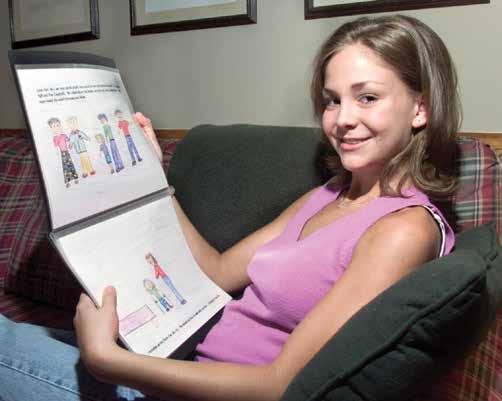
At the time, Jill was among fewer than 100 people in the United States to undergo rotationplasty. She decided on it after listening to a videotaped lecture by Dr. Neff.
“It showed all the things people could do — swim, ride bicycles and run. You couldn’t even tell the difference.”
The youngster returned to Harvey Oaks Elementary School and even played softball that summer.
Dr. Neff, she said, was her hero. The orthopaedic surgeon celebrated his patient’s recovery with a Soap Box Derby car, which Jill dubbed the Neffmobile.
Over the course of her yearlong treatment, Jill, who became a dental hygienist, wrote a book called “A Change of Plans,” which she dedicated to Dr. Neff.
In it, she noted, “Dr. Neff means everything to me. He saved my life the best way he could by doing the rotationplasty surgery, which lets me do more of the things I enjoy. He is gentle, kind, nice — dedicated to kids. I can tell he cares … He always tells me the truth … He makes cancer seem not so bad after all.”
ORTHOPAEDIC SPECIALTIES 115
August 2000: Jill Stephenson, a soon-to-be-college freshman at UNL, wrote and illustrated a book when she was 10 years old that dealt with the cancer experience that left her with one prosthetic leg.
Adult Reconstruction
Adult reconstruction surgeons at the University of Nebraska Medical Center specialize in the surgical treatment of bone and joint disorders and play an important role in the development of joint arthroplasties, corrective osteotomies, implants, biomaterials, bone, cartilage and soft tissue research. Post-traumatic, inflammatory and degenerative problems of all joints, including the knee, hip, elbow and shoulder, are successfully treated hundreds of times a year.
Surgeons perform joint-sparing procedures such as tibial, femoral and acetabular osteotomies. Surgeons consult with and receive assistance from the departments of Internal Medicine, Radiology, Physiatry, and other medical and surgical subspecialties. Hundreds of total knee and total hip replacements are conducted each year, with a strong emphasis on the complex revision cases.
The clinical joint replacement activity is supported by a strong biomechanics laboratory which is growing into a leading international simulation and testing research facility for total joint replacement implants.
New Hip, New Courses of Activity
Omahan Mark Goodall enjoys being active. Disc golf and world travel are among his favorite pursuits.

In autumn 2015, he was playing disc golf at Hummel Park when he kicked a stick in his path. His foot hooked a tree root instead and Goodall took an ugly spill. He didn’t immediately seek medical attention, but knee and hip pain eventually led him to a sports medicine doctor.
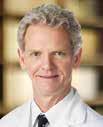


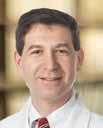
Pain during a trip to Paris in October 2017 convinced Goodall to consult Dr. Beau Konigsberg. The adult reconstruction surgeon diagnosed an arthritic right hip with a flexion contracture and extremely limited internal and external rotation.
Goodall underwent successful hip replacement surgery the next month. He was able to walk the day of the surgery and left the hospital the following day, thanks to UNMC’s Rapid Recovery Program utilizing a specialized anesthetic block and preoperative orthopaedics education.
Goodall quickly progressed to walking without pain. Too soon to play on the hilly Hummel Park disc golf course, he brought the course to himself by throwing discs at baskets on his lawn. He also returned to his hobby of found-object assemblages and volunteers as a collaborating artist with Girl Scouts of Nebraska.
116
Kevin Garvin, M.D., Chair Curtis Hartman, M.D. Beau Kildow, M.D. Beau Konigsberg, M.D.
Renewed Vitality
Susan Miller-Harsin was 8½ months pregnant in March 1994. She, her husband and their two sons had recently moved from Omaha to a country home in Blair, Nebraska. Two-year-old Josh tumbled down the stairs to the basement one morning. In a rush to console him, Susan fell.

Throughout her pregnancy, Susan had hip pain that was dismissed by her prenatal care providers. Whether an impending stress fracture caused her fall, or the trip caused the break is unknown; but Susan was rendered motionless at the foot of the stairs. Zach, 4, was able to call 9-1-1 for help. Susan was taken to Memorial Community Hospital in Blair, and later a hospital in Omaha, because the now distressed baby was in a hurry to send her into labor. Doctors calmed the baby in utero and an orthopaedic surgeon pinned her femoral neck fracture — placing several screws across the bone. She delivered Drew by caesarian section two weeks later, and spent time caring for her three young boys from a wheelchair.
Six months passed and Susan returned to her orthopaedic surgeon complaining of pain. Her concerns were again rebuffed, and it was suggested that she return in a year to have her hip replaced. Susan was frustrated. A friend referred her to Dr. Kevin L. Garvin in December 1994. He identified a nonunion where the femoral neck had failed to heal. Susan was also suffering from avascular necrosis in the ball of her hip (a lack of blood supply to the bone tissue that ultimately causes collapse and arthritis). Knowing that she would ultimately need a total hip arthroplasty and that many doctors would choose to perform one immediately, Dr. Garvin knew that prosthetic materials weren’t ideal, and believed it was best to help her keep her own parts as long as possible.
In January 1995, he performed a femoral osteotomy to help the nonunion heal and a revascularization procedure for her avascular hip bone to postpone total hip replacement and improve her condition. The surgery was successful and Susan resumed an active lifestyle for nearly 10 years, but when walking up a flight of stairs felt daunting, she knew it was time to return to Dr. Garvin.
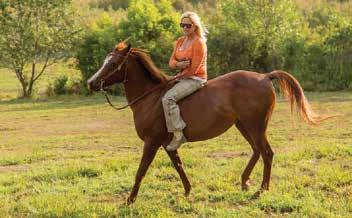
On Feb. 6, 2004, Dr. Garvin replaced her hip using a newly developed highly crosslinked polyethylene implant. At the time, Dr. Garvin had three material options for the hip replacement, including metal-on-metal, ceramic-on-ceramic and highly crosslinked polyethylene — a biomaterial introduced in 1999. He felt that the latter was the best fit for Susan’s youth and activity. Today, she has no pain and is as busy as ever — horseback riding, managing her equine therapy business, bike riding and swimming.
“My husband is an athlete. My kids are athletes. That’s our world. I wouldn’t have been able to participate in their world the way I do now if it weren’t for Dr. Garvin.”
— Susan Miller-Harsin
ORTHOPAEDIC SPECIALTIES 117
Pediatric
The specialty-trained pediatric orthopaedic surgeons at UNMC are dedicated to the care of all musculoskeletal problems in infants, children and adolescents. These physicians treat limb and spine deformities (club feet, scoliosis, hip dislocations, for example); gait abnormalities; bone and joint infections; and fractures and dislocations of the arms, legs and spine.


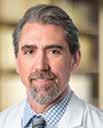
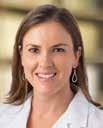



A full range of supportive care such as physical therapy and medical specialty care ensures the highest level of treatment for complex problems. Children with spina bifida, cerebral palsy, muscular dystrophy and other congenital and developmental problems receive coordinated care in pediatric orthopaedics.
Standing Tall, Moving Well
Like many 14-year-olds, Ian Hemmett and his twin brother, Nolan, are always on the go. It’s hard to believe that there was a time when doctors — and the teens’ parents, Lori and Michael — weren’t sure if Ian would ever run, bike or play sports.
Ian and Nolan were born prematurely at 31 weeks. About two weeks later in the NICU, Ian started showing signs of pain in his hip. “We would lift his legs for a diaper change and he would scream,” Lori said.
Tests revealed a methicillin-resistant Staphylococcus infection in Ian’s left hip and an elbow. Strong IV antibiotics and emergency surgery to drain his left hip rid the infection, but signaled the start of a long road ahead for the newborn.
At 3 months old, an ultrasound revealed a hip abnormality. Ian’s surgeon consulted closely with a neonatologist and with Walter Huurman, M.D., a senior pediatric orthopaedic surgeon at Children’s Hospital & Medical Center, and a professor of orthopaedic surgery at UNMC at the time. They decided to try a Pavlik harness, commonly used to treat infant hip dysplasia.
After six months in the harness, a CT arthrogram confirmed significant abnormality of the growth of the infant’s upper femur.
122
Paul Esposito, M.D. Susan Scherl, M.D. Matthew Halanski, M.D. Brian Hasley, M.D.
Ryan Koeler, M.D. Nickolas Nahm, M.D. Maegen Wallace, M.D.
“The results were worrisome for significant ongoing deformity of the hips,” said Paul Esposito, M.D., professor of pediatric orthopaedics at UNMC, and clinical service chief of pediatric orthopaedics at Children’s.
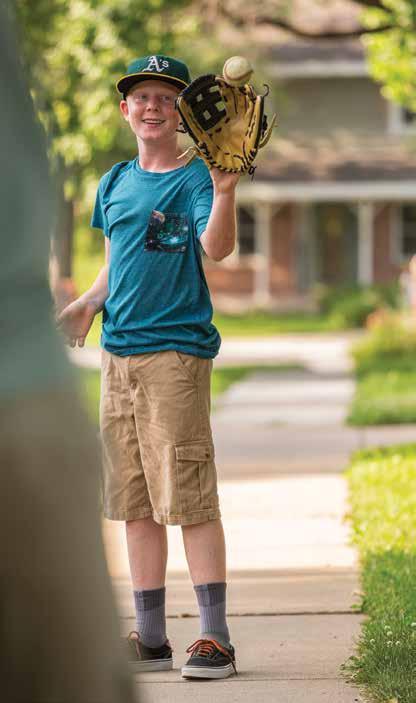
Dr. Esposito took over Ian’s case upon Dr. Huurman’s retirement and continued to monitor Ian’s growth. At 2 years old, an arthrogram showed that Ian’s infection had affected the growth potential of his upper femur. This manifested in a 2-centimeter difference in leg length by the time he turned 4. Ian had intermittent pain and started to develop a contracture in his left Achilles tendon from trying to stand on his toes to equalize his leg length, despite using a lift in his shoe.
Around age 7, Dr. Esposito performed a pelvic osteotomy of Ian’s left hip, with the goal of deepening the hip socket to gain length in his leg. He also performed an osteotomy with custom instrumentation with wires, in order to correct the deformity of his upper femur and gain additional length.
Besides a procedure to remove some of the hardware when Ian was in fifth grade, he continued with life like any active teenager. Today he only has a 1.5 cm difference in leg length, which requires only a small lift in his shoe, and enjoys excellent motion. While Ian is likely to require more treatment — and a potential hip replacement surgery — he most likely will do well into middle age.
ORTHOPAEDIC SPECIALTIES 123
“One thing I’ve learned is that I can’t ever use my condition as an excuse, because that’s going to get me nowhere.”
— Ian Hemmett
Giving Back In Significant Ways
The Department of Orthopaedic Surgery and Rehabilitation’s Wall of Honor permanently recognizes the remarkable individuals and organizations whose generosity has benefited departmental research, education and patient care. Installed in 2003, the tribute features brushed metal plaques with etched portraits of donors who have given $100,000 or more in support of the department’s mission. Their philanthropy is further acknowledged here.
Indebted to Loyal Philanthropists
Dr. Garvin’s greatest source of pride is the growth of the Department of Orthopaedic Surgery and Rehabilitation, something that would not have been possible without the support of the community.
“In the late 1990s, our state support was tremendous but it wasn’t sufficient to support sustained growth of the department,” he said. “I had the good fortune of taking care of individuals who were very philanthropic.”
People like Wall of Honor designees Harold and Marian Andersen, Charles Durham, Christina M. Hixson, Ruth and Bill Scott, Eileen and Dr. Wayne Ryan and Susie Buffett, among others. “These individuals and families are great supporters and continue to be supportive of the department’s research and education,” Dr. Garvin said.
As an example of ongoing support, in 2007, the Scotts contributed to the opening of the Nebraska Arthritis Outcomes Research Center on the third floor of UNMC’s Poynter Hall. The center, headed by Dr. James O’Dell and Dr. Garvin, would involve eight to 10 doctors and researchers on a full- or part-time basis. The Scotts’ philanthropy supported their salaries and access to national research databases.

134 WALL OF HONOR
In 2014, UNMC Physicians, Nebraska Medical Center and Bellevue Medical Center came together as Nebraska Medicine. That same year, a gift from the Scotts would enable the department to make an important move from the Durham Outpatient Center to the fourth floor of the new Lauritzen Outpatient Center at 4041 Leavenworth St.

In addition to office space for faculty, residents, academic support and research staff, the orthopaedics surgery department gained 28 cutting-edge exam rooms, an Orthopaedics Biomechanics and Advanced Surgical Technologies Laboratory, three conference rooms and a 75-seat auditorium.
Dr. Garvin recalled the conversation with Ruth Scott that led to the department finally operating in an optimal environment to serve to its tripartite mission of patient care, education and research.
“(She) asked if she could endow a chair in my name. I must’ve had some look that wasn’t as excited or as happy as she thought. She said, ‘Well is there something else?’ And I said, ‘Ruth, if you really want to help the department, they’re building a new outpatient center, and we’re in a very small area now. We need room to grow.’ After a brief conversation and a moment of silence, Ruth said, ‘Let me talk to Bill.’ And the rest is history.”

WALL OF HONOR 135
The Lauritzen Outpatient Center, 2020.
Bill and Ruth Scott, left, Warren Buffett, and his daughter, Susie Buffett, at UNMC’s Sorrell Center, where the Scotts received the University of Nebraska Regents Medal in 2009.
Kevin L. Garvin, M.D.

Momentum for the Next Century
THE 100-YEAR HISTORY OF ORTHOPAEDICS in Nebraska is a treasure-trove of pride, marked by surgeons who set down roots and dedicated themselves to making lasting impacts. Researching and writing this book has been both exciting and rewarding. Special thanks to the Omaha World-Herald, our publishing partner, for bringing our vision to life and, in the process, helping us celebrate a century of service.
Orthopaedic surgery’s beginnings in Nebraska can be traced to several key individuals who were undoubtedly inspired by Nicolas Andry’s definition of orthopaedics or orthopaidea: the rearing of children. Dr. John Prentiss Lord, the first chairman of the Department of Orthopaedic Surgery at the University of Nebraska from 1919 to 1931, devoted his life’s work to the Munroe-Meyer Institute and the caring for children with musculoskeletal disabilities.
Dr. H. Winnett Orr, Dr. Robert Schrock and Dr. James E.M. Thomson were early pioneers who played significant roles establishing orthopaedic surgery in Nebraska and leaving an indelible mark nationally and internationally by their influence. Each served as president of the American Academy of Orthopaedic Surgery.
In 1969, orthopaedic surgery in Nebraska changed as formal training of residents began under the direction of Dr. L. Thomas Hood. The residency was further developed and expanded with the first full-time chairman, Dr. John F. Connolly, who was followed by Dr. James R. Neff.
The growth in the residency from three residents per year under the direction of Dr. Connolly to the current five residents per year has paralleled the growth of the department to nearly 30 full-time orthopaedic surgeons and 25 residents. The department’s expansion, primarily over the last two decades, was accelerated by generous and thoughtful philanthropic support of friends of the department and grateful patients. The contributions of these distinguished individuals are recognized on our department’s Wall of Honor. Our faculty’s approach to patient care, inspired research and commitment to educating the best and brightest students are further testaments to this world-class department.
The future of orthopaedic surgery in Nebraska is secure. Clinical service has achieved nearly double-digit growth in each of the last several years; research success is at an all-time high with four National Institutes of Health grants and the new Davis Global Center with accredited advanced clinical surgical simulation having profound effects on resident education.
Need will continue to drive more growth. Musculoskeletal conditions are the foremost contributor to disability throughout North America. The four most common are carpel tunnel syndrome, tendinitis, rotator cuff disease and low back strain.
142 AFTERWORD
More than one-half of individuals age 18 and older and 3 out of 4 individuals age 65 and older suffer from one of these burdening diseases. They are without question the most common burden of Nebraskans, as well.

More than 7 million Americans are currently living with either a total hip or total knee replacement. The states with the highest prevalence (nearly 3%) include Nebraska, North Dakota, Iowa and Wisconsin and each has a prevalence that doubles the national average of 1.52%.
The prevalence of joint replacement is similar to the prevalence of stroke and myocardial infarction and much higher than the prevalence of heart failure.
Based on our aging population, an estimated 11 million will undergo joint replacement each year. Additionally, 70% of this population will live up to four decades, emphasizing the need for continued clinical and radiographic surveillance.

The Department of Orthopaedic Surgery is well-positioned to stay at the forefront of and reach new milestones in research, medical education and clinical care. The commitment of UNMC and Nebraska Medicine to assist the department in its mission, coupled with the dedication of our faculty, will write the story of orthopaedic medicine in Nebraska for the next 100 years.
Kevin L. Garvin, M.D. Professor and Chair L. Thomas Hood, M.D., Professor of Orthopaedic Surgery and Rehabilitation
AFTERWORD 143
Completed Studies 2008-2021
Official Study Title
Comparison of the Single vs. Double Incision Technique for Achilles Tendon Reconstruction with Flexor Hallucis Tendon Transfer — Is the Second Incision Really Necessary?
Osteotomy Healing in Pediatric Osteogenesis Imperfecta Patients Receiving Low-Dose Pamidronate Therapy Should Obese and Morbidly Obese Patients Wait for TJA?
Radial Head Replacement Stem Loosening and Its Association with Foreman Systems
Full Thickness Rotator Cuff Re- Tear Prevalence and Correlation with Shoulder Function in Patients 65 Years and Older
Evaluation of a Cuff Tear Arthropathy Hemiprosthesis for the Treatment of Glenohumeral Arthritis in the Presence of a Chronic Rotator Cuff Tear
Outcomes Following Fixation of Proximal Humerus Fractures with Short Intramedullary Locked Nail Displaced Femoral (Neck Fracture) Arthroplasty Consortium for Treatment and Outcomes (DFACTO)
Full Thickness Rotator Cuff Retear Prevalence and Correlation with Shoulder Function in Patients 65 Years and Older
Computed Tomographic and Functional Follow-Up of Glenoid Anchor Peg Component Fixation Utilizing Autologous Bone Graft in Total Shoulder Arthroplasty
A Study in the Simulation of Chondrocytes in 3-D Culture by Continuous Ultrasound
Assays of Stem Cell function in Clinical Aging Research
An Evaluation of Outcomes of Total Joint Arthroplasty in Orthotopic Liver Transplant Recipients
A Prospective Study on the Effect of surgical Treatment for Chronic Posttraumatic Headaches (Whiplash Associated Disorders) on Photophobia
Outcomes Following Acetabular Fracture
Distal Radius Fractures
Plate Augmentation for Femoral Shaft Nonunions Previously Treated with an Intramedullary Nail
Acute Bracing of Humerus Shaft Fractures
Incidences of Spondylolysis and Spondylolisthesis in Children with Osteogenesis Imperfecta
Clinical Results of the Anatomic Compression Arthrodesis Technique with Anterior Tension Band Plate Augmentation for Ankle Arthrodesis
Functional Outcomes after Plate Fixation of Humerus Shaft Fractures: Anterior Versus Posterior Approach
Linkage Analysis and Gene Mapping of Familial Spinal Disorders (Scoliosis, Scheuermann’s Kyphosis, Spondylolisthesis, Lumbar Disc Disease, Osteoporosis)
Functional Outcomes Following a Quad Snip Approach in Knee Revision Surgery
Why Are Total Hip Arthroplasties Revised?
Surgical Treatment Outcomes for Whiplash Associated Disorder
Long-term (24 -27 years) Follow-up after Total Hip Arthroplasty using a Tapered Tri-lock Component Inserted without Cement.
Evaluation of Functional Outcomes of Mini Open Rotator Cuff Repair Without Acromioplasty
Glenoid Anchor Peg component Fixation Utilizing Autologous Bone Graft in Total Shoulder Arthroplasty Follow-Up Follow-up of Shoulder Hemiarthroplasty with a CTA Head for Cuff-Tear Arthropathy
Functional Outcomes of Intra-Articular Distal Humerus fixation Through an Extensor Mechanism Sparing Posterior Approach
Orthopaedic Registry to Monitor Treatment Outcomes
Changes in Bacterial Species and Resistances in Infected Total Hip Arthroplasty Revisions
Principal Investigator
Timothy Fitzgibbons, MD
Paul W. Esposito, MD
Curtis W. Hartman, MD
Edward V. Fehringer, MD Edward V. Fehringer, MD Edward V. Fehringer, MD
Edward V. Fehringer, MD
Kevin L. Garvin, MD Edward V. Fehringer, MD Edward V. Fehringer, MD
Sean V. McGarry, MD
Margaret A. Kessinger, MD Kevin L. Garvin, MD N. Ake Nystrom, MD
Kevin L. Garvin, MD Edward V. Fehringer, MD Edward V. Fehringer, MD
Edward V. Fehringer, MD
Paul W. Esposito, MD Matthew A. Mormino, MD
Edward V. Fehringer, MD Edward V. Fehringer, MD
Kevin L. Garvin, MD
Kevin L. Garvin, MD N. Ake Nystrom, MD Kevin L. Garvin, MD
Edward V. Fehringer, MD Edward V. Fehringer, MD Daniel E. Firestone, MD
Resident study
Edward V. Fehringer, MD Kevin L. Garvin, MD
Year 2008 2009 2010 2011
156 COMPLETED STUDIES
2012
Horseback Riding and/or Motorcycle Riding After a Total Hip Arthroplasty
Periprosthetic Fractures of the Tibia After Total Knee Arthroplasty: An Overview and Description of a Surgical Technique Using Locking Plates, Cables and Augmentation with an Anterior 1/3 Tubular Plate
Results of Total Knee Arthroplasty Revision for Rotational Malalignment
CSSG Multi-center Retrospective and Prospective Observational Data Registry for Clinical and Radiographic Outcomes of Spinal Surgery Comparing Instrumentation and Procedures.
Is There Sufficient Orthopaedic Education in Medical School?
Cardiovascular Pathology and Surveillance in Osteogenesis Imperfecta
Revision Total Hip Arthroplasty with Impact Grafting
Functional Outcomes after Posterolateral Plate Fixation of Humerus Shaft Fractures
Prospective, Multicenter, Single-arm Study to Evaluate Efficacy, Safety, and Pharmacokinetics of Denosumab in Children with Osteogenesis Imperfecta
An analysis of the accuracy of radiographic reference markers for digital templating in total hip arthroplasty
Sonication for enhanced diagnosis of Prosthetic Joint Infection
Anterior Knee Pain after Intramedullary Nailing of Tibial Fractures by Suprapatellar Approach
Five Year Outcome Follow-up of Glenoid Anchor Peg component Fixation Utilizing Autologous bone Graft in Total Shoulder Arthroplasty
Clinical Results of Uncemented Tapered Stems with Total Hip Arthroplasty in patients aged 50 Years or Younger Outcomes after posterolateral plate fixation of humerus shaft Fractures
Plate Augmentation for Femoral Shaft Nonunions Previously Treated with an Intramedullary Nail
Initial Results and Experience with Intramedullary Rodding (Fassier-Duval Telescoping Intramedullary Rodding) in Children with Osteogenesis Imperfecta
Enhanced Detection of Staphylococcus Aureus Colonization in Patients Undergoing Prosthetic Joint Implantation
Evaluating the epidemiology of pediatric muscular skeletal injuries at one academic pediatric practice
Prepping the External Fixator in Situ During Two Stage Pilon Surgical Treatment: Postoperative Complications
Clinical outcomes comparison between a single injection of Hylan GF20 and a series of 5 injections of Sodium Hyaluronate in patients for treatment of osteoarthritis of the knee: A randomized prospective study
The Value of the On-Call Resident (Multi-Center)
Safety and efficacy of Liposomal Bupivacaine (Exparel) in Lumbar Spine Surgery
Hoverboard Injuries in Children (Multi-Center)
Operative Treatment of Forearm Deformities in Children with Osteogenesis Imperfecta
Low-energy open ankle fractures in the elderly. A Multi-center Retrospective Review Study
Pre-Surgical S. aureus Colonization and Outcomes of Total Joint Arthroplasty
Patient Outcomes Following Rotationplasty Treatment (Versus Expandable Prostheses) for Osteosarcoma of the Distal Femur or Proximal Tibia
A Fracture Boot Stress Model for the Determination of Ankle Stability in Patients with Isolated Fibular Fractures
The cause of and treatment for Total Knee Arthroplasty Stiffness
A retrospective review of Hybrid total Knee Arthroplasty outcomes
Prepping the external fixator in situ during two stage pilon surgical treatment: Postoperative complications
Pneumatic tourniquet use without padding in upper extremity surgery
Kevin L. Garvin, MD
Miguel S. Daccarett, MD
Beau S. Konigsberg, MD
Brian P. Hasley, MD
Medical student initiated Maegen J. Wallace, MD
Kevin L. Garvin, MD
Edward V. Fehringer, MD Eric Rush, MD Paul W. Esposito, MD
Curtis W. Hartman, MD
Curtis W. Hartman, MD Justin C. Siebler, MD Matthew J. Teusink, MD
Kevin L. Garvin, MD Miguel S. Daccarett, MD Ivan Tarkin, MD Paul W. Esposito, MD
Kevin L. Garvin, MD Susan A. Scherl, MD
Resident study Beau S. Konigsberg, MD
Matthew A. Mormino, MD
Resident study
Medical student initiated Maegen J. Wallace, MD
Miguel S. Daccarett, MD
Kevin L. Garvin, MD Sean V. McGarry, MD
Matthew A. Mormino, MD
Kevin L. Garvin, MD
Curtis W. Hartman, MD Matthew A. Mormino, MD Philipp N. Streubel, MD
2013 2014 2015 2016 2017
COMPLETED STUDIES 157
Year Official Study Title
Principal Investigator
Completed Studies, continued
Official Study Title
Prepping the external fixator in situ during two stage pilon surgical treatment: Postoperative complications
An Evaluation of Antibiotic Administration Treatment of Open Fractures
Surgeon Attire: Does what you wear in clinic matter?
Can pre-operative Rand SF-36 scores predict function outcomes from hip and knee arthroplasty?
A retrospective study on the association of internal injuries with femoral fractures
Long-Term follow-up of Joint Infections after Re-implantation
Evaluating Length of Hospital Stay (LOS) and Readmission Rates (RR) Following Total Hip Arthroplasty: Is there a correlation between LOS and RR? Do co-morbidities factor in LOS or RR?
Orthopaedic residents’ OITE study habits: A modern review
Early outcomes of a new design stem - The REDAPT revision femoral system
Study on incidence of proximal femur fractures after open reduction and internal fixation of distal femur fractures
Does prophylactic administration of TXA reduce mean operative time and perioperative blood loss in posterior approach lumbar spinal fusion surgery perform for degenerative spinal disease?
Long-term outcome follow-up of glenoid anchor peg component fixation utilizing autologous bone graft in total shoulder arthroplasty
Prospective observational study of donor-site morbidity following posterior iliac crest bone-graft harvest in thoracic and lumbar spinal fusion operations
Regional and seasonal variations in the incidence of post-traumatic infection after open extremity fractures CT vs. X-ray in measuring displacement and angulation in clavicle fractures
Postoperative outcomes of hip fracture surgery in older patients on clopidogrel or warfarin at the time of surgery
Defining the role of head of bed angle in cerebral deoxygenation events during upper extremity surgery in the beach chair position.
Proximal Humerus Fracture Database Registry
The utility of oral antibiotic therapy following 2-stage revision arthroplasty for infected prosthetic hips and knees.
Prevalence of Staph Aureus in patients undergoing total joint arthroplasty and the effectiveness of pre-operative decolonization in preventing post-operative infection
Comparison of Stretch Conductive Stockinette and Cast Saw Alarm System with Traditional Materials when Removing Long Arm Casts
Early Ambulation after Hip Fracture Surgery and the Effect on 30-Day Mortality
Review of Clinical Outcomes in Patients Requiring Long-Term Antibiotic Treatment for the Management of Orthopaedic Infections in Patient with and without a History of Recreational Intravenous Drug Use (RIVDU)
Does immediate postoperative opioid consumption correlate with long-term outcomes in patients undergoing one and two level posterior lumbar fusions
Pain Associated with Cemented and Press-Fit Long-Stemmed Tibial Components in Revision Total Knee Arthroplasty
Principal Investigator
Matthew A. Mormino, MD
Matthew A. Mormino, MD
Kevin L. Garvin, MD
Curtis W. Hartman, MD
Justin C. Siebler, MD
Kevin L. Garvin, MD
Kevin L. Garvin, MD
Joseph A. Morgan, MD
Curtis W. Hartman, MD
Justin C. Siebler, MD
Chris A. Cornett, MD
Matthew J. Teusink, MD Chris A. Cornett, MD
Justin C. Siebler, MD Matthew A. Mormino, MD
Justin C. Siebler, MD Matthew J. Teusink, MD
Philipp N. Streubel, MD
Curtis W. Hartman, MD Kevin L. Garvin, MD
Matthew A. Halanski, MD
Matthew A. Tao, MD Philipp N. Streubel, MD
Chris A. Cornett, MD
Beau S. Konigsberg, MD
Year 2018 2019 2020
2021
158 COMPLETED STUDIES
Current and Past Faculty
Name
Job Title
John A. Albers, MD Instructor
L. Russell Alberts, PhD Associate Professor
Brett Andres, MD Volunteer
Ryan M. Arnold, MD Volunteer
Stanley M. Bach, MD Associate Professor
Gordon D. Bainbridge, MD Instructor
Jackson J. Bence, MD Instructor
Donald D. Berg, MD Instructor
Patrick Bowman, MD V Volunteer
John Brantigan, MD Assistant Professor
David E. Brown, MD Assistant Professor
Dwight W. Burney Jr., MD Associate Professor
Charles F. Burt, MD Instructor
Thomas C. Bush, MD Assistant Professor
James Canady, MD Associate Professor
Shelby H. Carter, MD Clinical Instructor
Dennis Chakkalalkal, PhD Assistant Professor
Gary L. Chingren, MD Instructor
David J. Clare, MD Volunteer
Michael P. Clare, MD Assistant Professor
Patrick E. Clare, MD Volunteer
Robert M. Cochran II, MD Assistant Professor
John F. Connolly, MD Professor and Chair
Chris A. Cornett, MD Associate Professor
Lynn A. Crosby, MD Assistant Professor
Frederick L. Crouter, BEd, MEd Assistant Professor
Miguel S. Daccarett, MD Associate Professor
Douglas O. DeShazer, DDS Associate Professor
James W. Dinsmore, MD Associate Professor
Mark E. Dietrich, MD Associate Professor
John D. Douthit, MD Vice-Chair
Klaus Draenert, MD Volunteer
Robert W. Dugas, MD Volunteer
Kenneth W. Ellis, MD Instructor
Paul W. Esposito, MD Professor
Edward V. Fehringer, MD Associate Professor
Thomas P. Ferlic, MD Associate Professor
Daniel E. Firestone, MD Assistant Professor
Timothy Fitzgibbons, MD Clinical Instructor and Chief, Bergan Mercy Hospital-Omaha
Katie L. Freeman, MD Assistant Professor
Dwight M. Frost, MD Assistant Professor
Fred J. Fricke, MD Senior Consultant
Samuel I. Fuenning, MD Professor
William F. Garvin, MD Assistant Professor
Kevin L. Garvin, MD Professor and Chair
Glen M. Ginsburg, MD Associate Professor
Mark E. Goebel, MD Assistant Professor
Paul Goetowski, MD Clinical Assistant Professor
Name Job Title
William H. Gondring, MD Instructor
Ann C. Grandjean, EdD Clinical Instructor
R. Michael Gross, MD Volunteer
Steven V. Hagan, MD Assistant Professor
Hani Haider, PhD Professor
William R. Hamsa Sr., MD Chairman and Sr. Consultant
William R. Hamsa Jr., MD Associate Professor
Curtis W. Hartman, MD Associate Professor
Brian P. Hasley, MD Associate Professor
Matthew A. Halanski, MD Associate Professor
John A. Henke, MD Instructor
Scott Hodges, DO Spine Instructor
L. Thomas Hood, MD Professor and Chair/Senior Consultant Harold R. Horn, MD Instructor
James Q. Hossack, MS Professor of Civil Engineering
Walter W. Huurman, MD Professor Emeritus Kirk S. Hutton, MD Volunteer
O. Max Jardon, MD Professor M. Layne Jenson, MD Assistant Professor
Herman F. Johnson, MD Professor
August F. Jonas, MD Instructor
Donald G. Kanefield, MD Instructor
C. Michael Kelly, MD Clinical Instructor
David N. Kettleson, MD Assistant Professor
Reginald Q. Knight, MD Volunteer
Beau S. Konigsberg, MD Associate Professor
Bernard Kratochvil, MD Instructor
Anthony J. Lauder, MD Assistant Professor
Gene S. Lewallen, MD Assistant Professor
David Lindsay, MD Ehrling Bergquist Hospital Offutt AFB
Louis Lippiello, PhD Associate Professor
Michael C. Longley, MD Volunteer
John P. Lord, MD Professor and Chair
John “Jack” A. McCarthy, MD Volunteer John W. McClellan, III, MD Assistant Professor
Patricia A. McDougall, MD Assistant Professor
Scott T. McMullen, MD Volunteer
Sean V. McGarry, MD Associate Professor
Edward M. Malaschock, MD Associate Professor
Monte S. Mathews, MD Assistant Professor
Michael H. McGuire, MD Associate Professor
Morris B. Mellion, MD Associate Professor
R. Michael Mendlick, MD Assistant Professor
Bruce Miller, MD Assistant Instructor
David W. Minard, MD Associate Professor
Howard E. Mitchell, MD Assistant Professor
Joseph A. Morgan, MD Assistant Professor
Matthew A. Mormino, MD Professor and Program Chair
Fereydoon Namavar, PhD Professor
CURRENT AND PAST FACULTY 159
Current and Past Faculty
Name
Job Title
James R. Neff, MD Professor and Chair
Russell C. Nelson, DSc Professor
Michael T. O’Neil, MD Assistant Professor-Volunteer
Erik T. Otterberg, MD Volunteer
Howard D. Pachman, DPM Volunteer
Eugene W. Peck, MD Clinical Instructor
Eric D. Phillips, MD Clinical Instructor
Richard C. Pitner, MD Associate Professor
Sara M. Putnam, MD Assistant Professor
Samar K. Ray, MD Instructor
Lori K. Reed, MD Associate Professor
David Rhodes, MD Assistant Professor
Bradley C. Rosenberger, MD Clinical Assistant Instructor
Alexander B. Sawatzke, MD Assistant Professor
Jerry Schenkin, MD Associate Professor
Susan A. Scherl, MD Professor
Robert Schrock, M.D. Associate Professor
Ronald O. Schwab, MD Instructor
James Scott-Miller, MD Associate Professor
Todd D. Sekundiak, MD Associate Professor
Anthony B. Serfustini, MD Las Vegas, NV faculty
Justin C. Siebler, MD Associate Professor
William W. Smith, MD Instructor
Richard D. Smith, MD Associate Professor/Senior Consultant
William W. Smith, MD Instructor
Basil S. States, PhD Associate Professor
Warren Stinson, PhD Associate Professor
Frank P. Stone, MD Associate Professor
Basil S. Strates, MD, PhD Associate Professor
Philipp N. Streubel, MD Associate Professor
James K. Styner, MD Assistant Professor
Samuel A. Swenson Jr, MD Associate Professor
Matthew A. Tao, MD Assistant Professor
Frederick F. Teal, MD Professor
Matthew A. Teusink, MD Associate Professor
John M. Thomas, MD Associate Professor (Pediatrics)
James E.M. Thomson, M.D. Adjunct Professor
Jeffrey J. Tiedeman, MD Clinical Instructor
Scott A. Vincent, MD Assistant Professor
Maegen J. Wallace, MD Assistant Professor
W. Michael Walsh, MD Associate Professor
Chester H. Waters III, MD Instructor
Frederick S. Webster, MD Clinical Instructor
Edmund B. Weis Jr., MD Professor
Howard R. Woodward, MD Clinical Assistant Instructor
John C. Yeakley, MD Instructor
John G. Yost, MD Assistant Professor
PROJECT LEAD
Kevin L. Garvin, M.D., Professor and Chair, UNMC Department of Orthopaedic Surgery & Rehabilitation
EDITORS
Chris Christen
Susan Siebler
DESIGNER
Christine Zueck-Watkins
RESEARCHERS & WRITERS
Doug Meigs Blake Ursch Dan McCann
CONTRIBUTORS
Kristine Gerber
Kurt A. Keeler Anne Spielman
PHOTOGRAPHY
Scott Dobry
Department of Orthopaedics archives Omaha World-Herald archives
Leon S. McGoogan Health Sciences Library Kent Sievers, UNMC Strategic Communications
Copyright 2022. All rights reserved. No part of this book may be reproduced, stored in a retrieval system, or transmitted in any form or by any means, electronic, mechanical, photocopying, recording or otherwise, without prior consent of the publisher, University of Nebraska Medical Center.
Department of Orthopaedic Surgery and Rehabilitation 985640 Nebraska Medical Center Omaha, NE 68198-5640 www.unmc.edu/orthosurgery
Jeffrey P. Gold, M.D. Chancellor, University of Nebraska Medical Center
Executive Vice President & Provost, University of Nebraska
First Edition
ISBN: 978-1-7345923-6-8
Printed by Walsworth Publishing Co.
160 CURRENT AND PAST FACULTY
CELEBRATING 100 YEARS OF THE UNIVERSITY OF NEBRASKA MEDICAL CENTER DEPARTMENT OF ORTHOPAEDIC SURGERY AND REHABILITATION $45.00 9 781734 592368 54500> ISBN 978-1-7345923-6-8 $45.00







 The 1950s: A boy with his leg in traction after a football injury.
The 1950s: A boy with his leg in traction after a football injury.






























